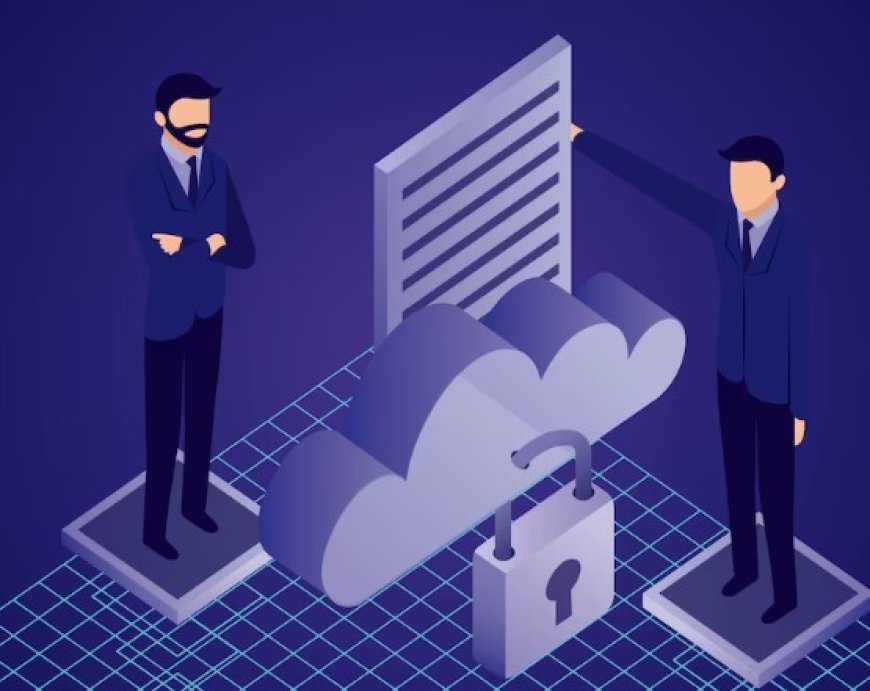Cloud Computing in Digital Transformation
Explore the vital realm of cloud security. Learn about strategies, best practices, and technologies to protect your data and applications in the cloud.

Cloud security refers to the practices and technologies used to protect data, applications, and infrastructure in cloud computing environments. It involves implementing security measures to safeguard information stored in the cloud, control access to resources, and mitigate risks associated with cloud-based services. Cloud security ensures the confidentiality, integrity, and availability of data and applications, allowing organizations to safely leverage the benefits of cloud computing while addressing potential security challenges.
Importance of cloud security in the modern digital landscape
-
Cloud security helps safeguard sensitive information such as customer data, financial records, and intellectual property from unauthorized access or data breaches.
-
Cloud security ensures compliance with industry-specific regulations and data protection laws, reducing the risk of legal and financial penalties.
-
Robust cloud security measures help maintain business continuity by preventing service disruptions, data loss, or unauthorized access to critical systems and applications.
-
Strong cloud security measures enhance customer trust, reputation, and confidence in the organization's ability to protect their data.
-
Effective cloud security enables organizations to scale their infrastructure and resources while ensuring the security of data and applications.
-
Implementing proper cloud security measures can help organizations avoid costly security breaches and minimize the impact of potential security incidents.
Overall, cloud security is crucial in today's digital landscape to mitigate risks, protect sensitive data, maintain compliance, and build trust with customers.
The purpose of this blog post is to provide an in-depth understanding of cloud security and its significance in today's digital landscape. It aims to educate readers about the importance of implementing robust cloud security measures, highlight common challenges and best practices, and explore emerging trends and technologies in the field of cloud security. By the end of the blog post, readers will have a comprehensive understanding of the importance of cloud security and be equipped with valuable insights to enhance their own cloud security practices.
Understanding Cloud Security
What Is Cloud Security?
Cloud security refers to the set of policies, technologies, and practices designed to protect data, applications, and infrastructure in cloud computing environments. It involves safeguarding sensitive information, ensuring privacy, maintaining data integrity, and managing access controls within cloud-based systems. Cloud security encompasses a range of measures, including encryption, identity and access management, vulnerability management, and network security, to mitigate risks and protect assets stored and processed in the cloud. The goal of cloud
security is to provide a secure and reliable environment for organizations to leverage the benefits of cloud computing while minimizing potential security threats and vulnerabilities.
Key components of cloud security
-
Implementing strong authentication and authorization mechanisms to control access to cloud resources.
-
Encrypting data at rest and in transit to ensure confidentiality and protect against unauthorized access.
-
Implementing firewalls, network segmentation, and intrusion detection and prevention systems to protect cloud networks from attacks.
-
Regularly scanning and patching cloud infrastructure and applications to address vulnerabilities and reduce the risk of exploitation.
-
Monitoring and analyzing cloud environments for security incidents, and maintaining logs for auditing and incident response.
-
Establishing processes and procedures to quickly respond to and recover from security incidents or breaches in the cloud environment.
-
Ensuring compliance with industry regulations and standards, as well as establishing governance policies to maintain security and accountability in the cloud.
Common Cloud Security Risks and Threats
In the cloud computing environment, there are several common security risks and threats that organizations need to be aware of and address. These include:
-
Unauthorized access to sensitive data stored in the cloud, leading to potential data loss or theft.
-
Vulnerabilities in cloud service APIs can be exploited by attackers to gain unauthorized access or manipulate data.
-
Improperly configured cloud services can expose sensitive data or grant excessive privileges, increasing the risk of unauthorized access.
-
Malicious or negligent insiders with access to cloud resources can intentionally or accidentally compromise security and privacy.
-
Distributed Denial-of-Service attacks can overwhelm cloud infrastructure, causing service disruptions and impacting availability.
-
Unintentional data deletion, corruption, or loss due to technical failures or inadequate backup and recovery mechanisms.
-
Compromised credentials or weak authentication mechanisms can lead to unauthorized access to cloud accounts and resources.
-
Failure to meet regulatory requirements and industry standards can result in legal consequences and reputational damage.
Essential Practices for Cloud Security
To ensure robust cloud security, organizations should adhere to the following essential practices:
-
Implement strong access controls and identity management measures to authenticate and authorize users accessing cloud resources.
-
Employ data encryption techniques to protect sensitive data both at rest and in transit within the cloud environment.
-
Conduct regular security assessments and audits to identify vulnerabilities, misconfigurations, and potential risks in the cloud infrastructure.
-
Continuously monitor cloud resources for suspicious activities and employ threat detection mechanisms to promptly respond to security incidents.
-
Provide comprehensive security awareness training to educate employees about cloud security best practices and the associated risks.
By implementing these practices, organizations can strengthen their cloud security posture and mitigate the potential risks and threats associated with cloud environments.
Cloud Security Best Practices for Different Cloud Deployment Models
Public Cloud:
-
Carefully review and understand the security measures and capabilities provided by the cloud service provider (CSP).
-
Implement strong access controls and configure appropriate user permissions.
-
Regularly monitor and analyze cloud activity logs for any suspicious or unauthorized access.
-
Encrypt sensitive data both in transit and at rest.
-
Implement network security measures, such as firewalls and intrusion detection systems (IDS).
Private Cloud:
-
Ensure the physical security of the private cloud infrastructure.
-
Implement strong access controls and authentication mechanisms.
-
Regularly update and patch all software and systems within the private cloud environment.
-
Establish and enforce security policies and procedures specific to the private cloud.
-
Regularly conduct security audits and penetration testing.
Hybrid Cloud:
-
Implement consistent security measures across both the public and private cloud components.
-
Establish secure communication channels and data transfer protocols between the public and private cloud environments.
-
Ensure proper data segregation and classification to maintain confidentiality and integrity.
-
Implement identity and access management solutions to manage user permissions and access controls across both environments.
-
Regularly monitor and assess the security posture of both the public and private cloud components.
Cloud Security Tools and Technologies
Cloud security tools and technologies play a crucial role in safeguarding cloud environments. Here are some key tools and technologies commonly used for cloud security.
-
CASBs provide visibility and control over cloud services, enforcing security policies and protecting data in the cloud.
-
IAM solutions manage user identities, access permissions, and authentication mechanisms for cloud services.
-
Encryption technologies protect sensitive data by encrypting it at rest and in transit, with key management systems ensuring secure key storage and access.
-
SIEM solutions collect and analyze security event data from cloud environments, enabling proactive threat detection and incident response.
-
CWPPs offer security for cloud workloads, monitoring and protecting against threats specific to cloud environments.
-
Container security tools provide visibility and protection for containerized applications and their underlying infrastructure.
-
Serverless security solutions focus on securing serverless architectures and functions, ensuring code integrity and preventing vulnerabilities.
-
Cloud-native security tools are designed specifically for cloud-native environments, addressing security challenges associated with microservices, containers, and orchestration platforms.
By leveraging these tools and technologies, organizations can enhance the security of their cloud deployments and protect against evolving threats.
Emerging Trends and Future of Cloud Security
Cloud security is constantly evolving to address new challenges and leverage emerging technologies. Here are some key trends shaping the future of cloud security:
Zero-trust architecture:
Organizations are moving towards a zero-trust approach, where access controls are strictly enforced, and continuous verification is required for all users, devices, and applications in the cloud environment.
Container security:
As containerization becomes more prevalent, there is a growing focus on securing containerized environments, ensuring that containers are built securely, and implementing measures to protect against vulnerabilities and runtime threats.
Cloud-native security:
With the adoption of cloud-native technologies like serverless computing and microservices, cloud-native security solutions are being developed to address the unique security challenges presented by these architectures.
AI-driven cloud security solutions:
Artificial Intelligence (AI) and Machine Learning (ML) are being applied to enhance cloud security, enabling real-time threat detection, automated incident response, and anomaly detection to effectively mitigate risks.
These trends indicate a shift towards more dynamic and adaptive approaches to cloud security, incorporating advanced technologies and strategies to protect against evolving threats and secure cloud environments effectively. By embracing these trends, organizations can stay ahead of emerging risks and strengthen their overall cloud security posture.
Cloud security is of paramount importance in today's digital landscape. Organizations must prioritize the protection of their cloud environments to safeguard sensitive data, maintain compliance, and mitigate risks. Key takeaways for enhancing cloud security practices include implementing robust security measures, leveraging encryption and access controls, regularly monitoring and auditing cloud environments, and staying updated with evolving threats and best practices. As the cloud security landscape continues to evolve, organizations should anticipate and adapt to emerging trends and technologies to ensure a strong and resilient cloud security posture.




































